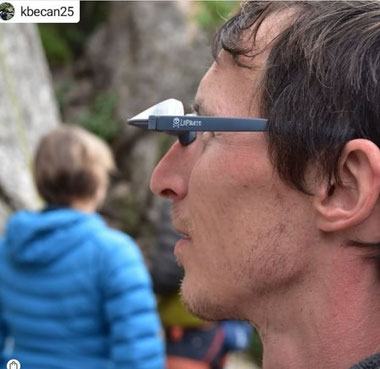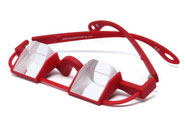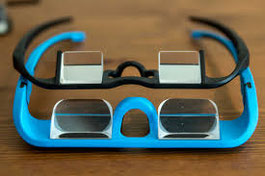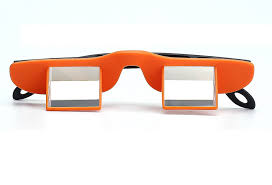The use of prism lens glasses for climbing has become a widespread, and it is safe say that more than half of the belayers in most European climbing areas and climbing gyms use this gadget, making us look like we are being belayed by robots staring fixedly ahead at the rock face.
In only a few years, we have gone from having only option for glasses, to the more than 18 models that are currently available. As such, choosing a pair of belay glasses has become slightly more complicated, and I hope the tips I give you will prove to be useful.
First things first: Do I need belay glasses?

Owning a pair of belay glasses is highly recommended if you meet one or more of the following criteria:
- You belay frequently
- You belay for extended periods of time, such as on long routes, when your climbing partner is working a route, competitions, courses, etc.
- You have back problems such as disc protrusions, hernias, etc.
The acquisition of a pair of belay glasses is almost always due to neck pain, but you shouldn’t wait until then to get yourself a pair. What is more, the problems caused by belaying without glasses are often confused with actual climbing injuries, and we therefore don’t tend to attribute them to an incorrect belaying posture.
Another great advantage of belaying with prism lens glasses is that you concentrate on, and pay more attention to, your climbing partner.
Plastic or metal?
Metal belay glasses were the first to be brought onto the market, by their inventor, Albert Schneider. Metal is more durable and the frame is less likely to break. However, they are also the most expensive models, and they tend to get deformed with use, generating uncomfortable, albeit correctable, double vision. They are mistakenly thought to be the lightest models, but the weight of the glasses depends mainly on the size of the prism lens.
Plastic belay glasses are becoming more and more common, due to their lower cost and good performance. The frame may be less resistant to bending and knocks, but one must remember that the most delicate part of these types of glasses are the prism lenses.


Large or small prism lenses?

Large prism lenses give you a broader field of vision, and adapt better to all face shapes. Not everyone has the same distance between their eyes, so broad prism lenses satisfy a larger public. Large prism lenses also reduce the feeling of dizziness.
On the other hand, small prism lenses reduce the weight of the glasses significantly, and increase your vision of the surroundings.
NOTE: None of the prism lens belay glasses have a magnifying effect. If you get that feeling, remember that it is similar to when you look through a tube and it seems to cause a telescopic effect.
Glasses with large prism lenses include: LePirate, Simond (Decathlon) y Belaggles.
Glasses with small prism lenses include: Y&Y, CU, Metolius, LACD, Pitch Six, Crush Vision, Belay Specs, Tembo, etc
Belay glasses vs reading glasses
On some DIY websites, you can still find information on how to transform cheap glasses meant for reading while lying down, into belay glasses. On internet sales platforms you can also find glasses like those in the image, originating from a simple modification of the reading glasses.
Their main problem is the angle of vision. With these glasses you will have to bend your neck back a little more, so they only provide a partial solution to the bad belaying posture. An additional inconvenience is that they significantly block your peripheral vision, so you can’t see irregularities on the ground, the rope, and other important elements, as well.
A couple of year back, the savings might have compensated for the negative aspects, but nowadays, the price of belay glasses designed specifically for climbing has gone down considerably, to the point where they are almost equal in price to the reading glasses, removing the only advantage that the reading models had.
Models based on reading glasses are: LePirate (model 1), Topside, Fit4OLYMP,

Classic modified reading glasses. Not recommended.
How important is weight?
In climbing, weight is very important. But… do you climb with belay glasses? Unless you take them with you when doing multi-pitch routes, they normally stay at the base of the crag.
The difference between the heavy and light models is around 50 grams, so you won’t notice this weight difference in your backpack. What you will notice is that the light glasses irritate the bridge of the nose less, and do not move as much when you incline your head or make sudden movements. However, on the downside, they have smaller prism lenses, which reduces your field of vision.


Write a comment